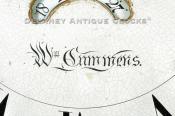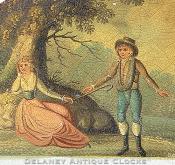William Cummens of Roxbury, Massachusetts. A mahogany case grandfather clock. PP-158.
This mahogany case example is very nicely proportioned and has a long history of ownership in the Roxbury Area.
The fine mahogany case exhibits very good proportions. The layout of this case does not include richly-grained mahogany veneers or brass stop-fluted quarter columns. It is solidly constructed and illustrates through its overall form that Roxbury cases can stand on their proportions alone. We have owned a fair number of these simpler-designed cases with other Roxbury Makers signed on the dial. Benjamin, Simon, Ephraim, and Aaron Willard examples are known to us. This case form must have been ordered by a true Yankee.
The mahogany wood retains an older shellac finish that has mellowed over time. Many scholars would consider this an original finish. The base stands four applied ogee bracket feet. They are well-formed and are applied to the bottom of a double-step molding. The base panel features a mahogany panel that exhibits a long sweeping grain pattern and is positioned horizontally. The waist section is long and narrow. It is fitted with a large tombstone-shaped waist door. This door is trimmed with a simple molded edge. The bonnet features a traditional pierced and open fretwork design and is surmounted with three brass ball and spiked finials. The bonnet door is arched and fitted with glass. The two smoothly turned bonnet columns flank the bonnet door. They are free-standing and mounted into brass capitals. They provide the illusion of supporting the upper bonnet molding.
The iron dial is nicely paint decorated. The four spandrel areas feature large lacy gilt designs. Under which is an applied layer of gesso that raises much of this design detail on the dial. A colorful painted pastoral scene is depicted in the lunette. A well-dressed couple is together under a large tree. This tree is on the bank of a slow-moving river just outside of town. The young woman is seated. She is well dressed and is handing the young gentleman a sheep herding staff. She appears to be slightly blushing as she turns away from the boy. This boy is a reoccurring figure in a number of painted dials produced by Boston's Nolen & Curtis dial firm. Here, the boy is wearing blue pants, a scarf, and a wide-brimmed hat. This dial displays hours, minutes, seconds, and calendar day in a traditional format. This dial is signed by the Maker, "Wm. Cummens," in fancy lettering.
This fine movement is constructed in brass and is of good quality. Four turned pillars support the two brass plates. Hardened steel shafts support the polished steel pinions and brass gearing. The winding drums are grooved. The escapement is designed in a recoil format. The movement is weight driven and designed to run eight days on a full wind. It is a two-train or a time-and-strike design having a rack and snail striking system. As a result, it will strike each hour on the hour. This is done on a cast iron bell which is mounted above the movement. The History of ownership in the local area is determined by the repair notations found scratched into the front plate. Elnathan Taber serviced this clock multiple times. Two dates he recorded are in February of 1839 and May of 1859.
This austere example was made circa 1795. It stands approximately 7 feet 10.5 inches tall to the top of the center finial.
Inventory number PP-158.
William Cummens was born in 1768 and died in Roxbury, Massachusetts, on April 20, 1834. He was 66 years old. William worked in Roxbury as a clockmaker as early as 1789. He learned clockmaking from Simon Willard. In fact, he was an apprentice in Willard's shop about the same time that Elnathan Taber was training. After serving his apprenticeship, Cummens stayed in Roxbury and worked alongside the Willard clockmaking family for many years. Based on the large number of clocks that have survived, Cummens and the Willards must have had an excellent relationship with one another. In this Roxbury location, Cummens had direct access to the same suppliers, such as case makers and dial painters, that the Willard family used. As a result, his clocks are nearly identical in form. Cummens was one of the first persons authorized by Simon Willard to manufacture Simon Willard's Patented Timepiece. The patent was granted in 1802. Over the past 55-plus years of buying and selling clocks, we have owned and sold a substantial number of tall case clocks, Massachusetts shelf clocks, and wall timepieces signed by this important clockmaker.
















